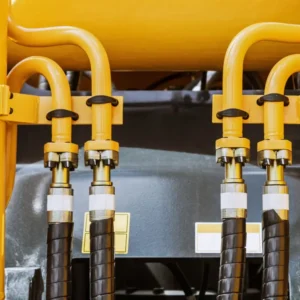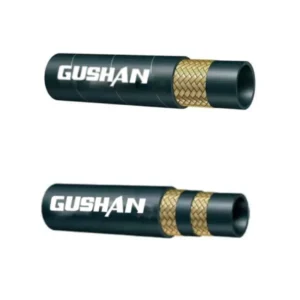Understanding the flow rate of hydraulic hoses, measured in gallons per minute (GPM), is crucial for optimizing hydraulic system performance. A hydraulic hose GPM chart serves as an essential tool for selecting the right hose size and ensuring efficient fluid transfer.
This guide will demystify GPM charts, explaining their importance and how to use them effectively. We’ll cover factors influencing flow rate, how to interpret chart data, and practical applications for various hydraulic systems, empowering you to make informed decisions.
What Is GPM
In the industry of hydraulic systems, GPM stands for “gallons per minute.” It’s a crucial measurement that indicates the volume of fluid flowing through a system within a specific time frame. Essentially, GPM quantifies the flow rate of hydraulic fluid.
Here’s hydraulic hose GPM significance:
Flow Rate Measurement:
- GPM provides a standard unit for measuring the volume of hydraulic fluid that moves through a hose or system per minute.
- This measurement is essential for determining the capacity and efficiency of hydraulic systems.
System Performance:
- The GPM rating of a hydraulic system directly impacts its performance.
- An insufficient GPM can lead to sluggish operation and reduced efficiency, while an excessive GPM can cause pressure drops and damage to components.
- GPM is a key factor in hose sizing, and pump sizing.
Hydraulic Hose GPM Chart
It’s important to understand that a single, universally applicable “Hydraulic Hose GPM Chart” is difficult to provide. This is because the optimal GPM (gallons per minute) for a hydraulic hose depends on a combination of factors, including:
- Hose Inside Diameter (ID): Larger IDs allow for higher GPM.
- Fluid Velocity: The speed at which the fluid moves through the hose.
- Fluid Viscosity: The thickness of the hydraulic fluid.
- System Pressure: The operating pressure of the hydraulic system.
However, I can offer some general information and a simplified table to illustrate the relationship between hose ID and GPM.
Key Concepts:
- Fluid Velocity: It’s crucial to maintain appropriate fluid velocity to prevent excessive pressure drops and heat generation. Recommended velocities vary depending on the type of hydraulic line (suction, pressure, return).
- Nomographic Charts: In the hydraulic industry, nomographic charts are frequently used to help calculate the correct hose size based on flow rate and fluid velocity.
General Guidelines:
- Suction lines typically require lower fluid velocities (2-4 ft/sec).
- Pressure lines can handle higher velocities (15-25 ft/sec, depending on pressure rating).
- Return lines usually fall within the 10-15 ft/sec range.
It is very important to understand that this table is a very simplified version, and real world applications will vary greatly.
| Hose Inside Diameter (inches) | Approximate GPM Range (at typical velocity) |
| 1/4″ | 2 – 5 GPM |
| 3/8″ | 5 – 10 GPM |
| 1/2″ | 10 – 20 GPM |
| 3/4″ | 20 – 40 GPM |
| 1″ | 40 – 80 GPM |
Important Notes:
- This table is a rough estimate. For precise calculations, consult hydraulic hose manufacturers‘ catalogs or use specialized hydraulic calculators.
- Always consider the specific requirements of your hydraulic system and follow industry best practices.
- For the most accurate information, consult with hydraulic system professionals, and refer to manufactures specifications.
Hydraulic Hose GPM Calculator
It’s important to understand that a “Hydraulic Hose GPM Calculator” often refers to tools that help determine various aspects of fluid flow within hydraulic systems, rather than a single, simple GPM calculation. These calculators often factor in several variables. Here’s a breakdown of what these calculators do and where to find them:
What Hydraulic Hose GPM Calculators Do:
Flow Rate Calculation:
- These tools help determine the volume of fluid flowing through a hose per minute (GPM).
Fluid Velocity:
They calculate the speed at which fluid moves through the hose, which is crucial for preventing excessive pressure drops and heat generation.
Pressure Drop:
Many calculators also determine the pressure loss that occurs as fluid flows through the hose, which is essential for system efficiency.
Ultimately, these calculators assist in selecting the appropriate hose size for a given application.
Where to Find Hydraulic Hose GPM Calculators:
Online Calculators:
- Many websites offer free online hydraulic calculators. These tools often allow you to input variables like hose diameter, fluid viscosity, and pressure to calculate flow rates and pressure drops. Examples of websites that offer these type of calculators are:
- Calculator.academy
- Evolution Motion Solutions
- OneHydraulics
- Websites from hydraulic hose manufacturers.
Manufacturer’s Catalogs:
Hydraulic hose manufacturers often provide detailed catalogs with charts and formulas for calculating flow rates and pressure drops.
Hydraulic Software:
Professional hydraulic system designers may use specialized software that includes advanced calculation tools.
Key Factors to Consider:
- Hose Inside Diameter (ID): This is a primary factor affecting flow rate.
- Fluid Viscosity: The thickness of the fluid influences its flow.
- System Pressure: The operating pressure of the system impacts fluid velocity and pressure drop.
- Hose Length: Longer hoses result in greater pressure drops.
When using these calculators, always ensure you have accurate input data and understand the limitations of the tool.
Hydraulic Hose GPM Calculator
1/2 Hydraulic Hose Flow Rate GPM
The flow rate, measured in gallons per minute (GPM), of a 1/2 inch hydraulic hose is dependent on several factors, primarily the fluid velocity. Fluid velocity, expressed in feet per second (ft/s), significantly impacts the GPM. A higher fluid velocity will result in a greater flow rate. For example, with a fluid velocity of 15 ft/s, a 1/2 inch hydraulic hose can achieve an approximate flow rate of 9.18 GPM.
It’s important to understand that this is a simplified calculation. Real-world applications involve additional considerations such as fluid viscosity, hose length, and system pressure, all of which can influence the actual flow rate. Consulting hydraulic system design guides and manufacturer specifications is crucial for precise calculations and optimal system performance.
Therefore, while a general estimation can be made, it’s always best to use accurate input variables and consult professional resources when designing or maintaining hydraulic systems to ensure safety and efficiency.
Conclusion
Understanding hydraulic hose GPM charts is essential for optimizing system performance and safety. These charts provide critical data for selecting the right hose size, ensuring efficient fluid flow and preventing costly failures. Accurate GPM calculations are key to maintaining operational integrity.
Properly utilizing GPM charts minimizes pressure drops and heat generation, prolonging hose lifespan and enhancing system reliability. This knowledge empowers operators to make informed decisions, leading to increased productivity and reduced downtime.
For high-quality hydraulic hoses and competitive wholesale pricing, consult Gushan Rubber. We offer a wide range of hoses to meet your specific GPM requirements. Contact us today for a personalized quote.



